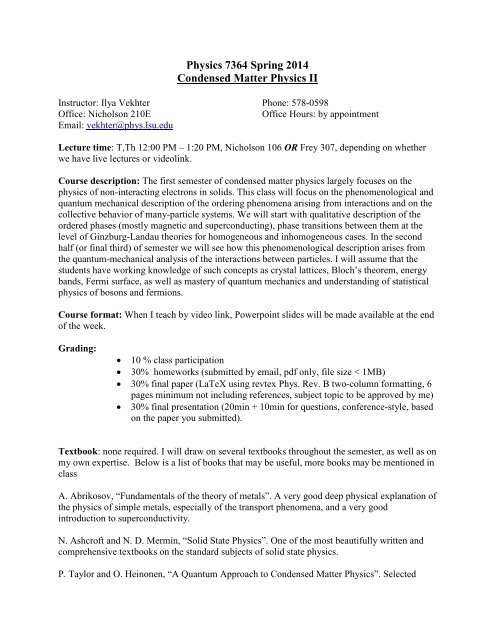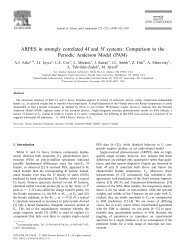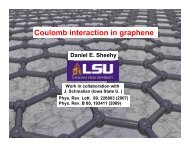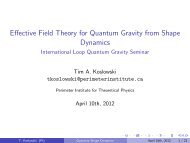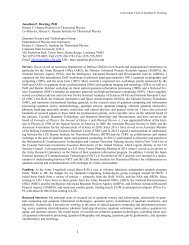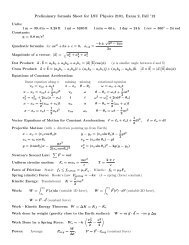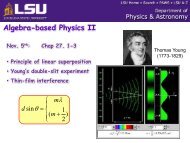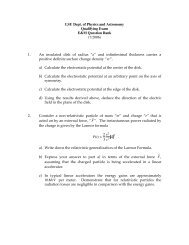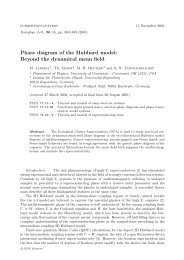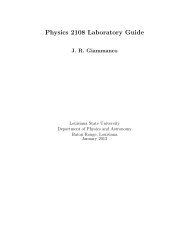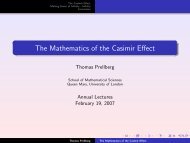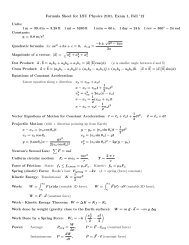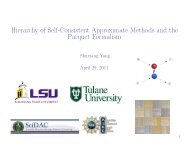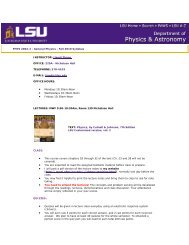available in pdf here
available in pdf here
available in pdf here
You also want an ePaper? Increase the reach of your titles
YUMPU automatically turns print PDFs into web optimized ePapers that Google loves.
Physics 7364 Spr<strong>in</strong>g 2014<br />
Condensed Matter Physics II<br />
Instructor: Ilya Vekhter Phone: 578-0598<br />
Office: Nicholson 210E<br />
Office Hours: by appo<strong>in</strong>tment<br />
Email: vekhter@phys.lsu.edu<br />
Lecture time: T,Th 12:00 PM – 1:20 PM, Nicholson 106 OR Frey 307, depend<strong>in</strong>g on whether<br />
we have live lectures or videol<strong>in</strong>k.<br />
Course description: The first semester of condensed matter physics largely focuses on the<br />
physics of non-<strong>in</strong>teract<strong>in</strong>g electrons <strong>in</strong> solids. This class will focus on the phenomenological and<br />
quantum mechanical description of the order<strong>in</strong>g phenomena aris<strong>in</strong>g from <strong>in</strong>teractions and on the<br />
collective behavior of many-particle systems. We will start with qualitative description of the<br />
ordered phases (mostly magnetic and superconduct<strong>in</strong>g), phase transitions between them at the<br />
level of G<strong>in</strong>zburg-Landau theories for homogeneous and <strong>in</strong>homogeneous cases. In the second<br />
half (or f<strong>in</strong>al third) of semester we will see how this phenomenological description arises from<br />
the quantum-mechanical analysis of the <strong>in</strong>teractions between particles. I will assume that the<br />
students have work<strong>in</strong>g knowledge of such concepts as crystal lattices, Bloch’s theorem, energy<br />
bands, Fermi surface, as well as mastery of quantum mechanics and understand<strong>in</strong>g of statistical<br />
physics of bosons and fermions.<br />
Course format: When I teach by video l<strong>in</strong>k, Powerpo<strong>in</strong>t slides will be made <strong>available</strong> at the end<br />
of the week.<br />
Grad<strong>in</strong>g:<br />
• 10 % class participation<br />
• 30% homeworks (submitted by email, <strong>pdf</strong> only, file size < 1MB)<br />
• 30% f<strong>in</strong>al paper (LaTeX us<strong>in</strong>g revtex Phys. Rev. B two-column formatt<strong>in</strong>g, 6<br />
pages m<strong>in</strong>imum not <strong>in</strong>clud<strong>in</strong>g references, subject topic to be approved by me)<br />
• 30% f<strong>in</strong>al presentation (20m<strong>in</strong> + 10m<strong>in</strong> for questions, conference-style, based<br />
on the paper you submitted).<br />
Textbook: none required. I will draw on several textbooks throughout the semester, as well as on<br />
my own expertise. Below is a list of books that may be useful, more books may be mentioned <strong>in</strong><br />
class<br />
A. Abrikosov, “Fundamentals of the theory of metals”. A very good deep physical explanation of<br />
the physics of simple metals, especially of the transport phenomena, and a very good<br />
<strong>in</strong>troduction to superconductivity.<br />
N. Ashcroft and N. D. Merm<strong>in</strong>, “Solid State Physics”. One of the most beautifully written and<br />
comprehensive textbooks on the standard subjects of solid state physics.<br />
P. Taylor and O. He<strong>in</strong>onen, “A Quantum Approach to Condensed Matter Physics”. Selected
subjects covered from the fully quantum viewpo<strong>in</strong>t.<br />
P. Fazekas, “Lecture Notes on Electron Correlations and Magnetism”,<br />
A. Auerbach “Interact<strong>in</strong>g electrons and Quantum Magnetism”,<br />
D. Matthis “Theory of Magnetism”,<br />
L. D. Landau and E. M. Lifshitz, “Electrodynamics of cont<strong>in</strong>uous media”, “Statistical Physics<br />
Vol. 2”<br />
M. T<strong>in</strong>kham, “Introduction to superconductivity”.<br />
P. Phillips, “Advanced Solid State Physics”.<br />
Course website: http://www.phys.lsu.edu/faculty/vekhter/Teach<strong>in</strong>g.html<br />
Topics covered <strong>in</strong> class: We will cover most of the follow<strong>in</strong>g subjects:<br />
• Magnetic systems near the transition. G<strong>in</strong>zburg-Landau expansion.<br />
• G<strong>in</strong>zburg-Landau theories for the first and second order phase transitions.<br />
• G<strong>in</strong>zburg-Landau theories for ferromagnets and antiferromagnets. Doma<strong>in</strong> wall structure.<br />
Magnetization curves. Magnetic anisotropy. Sp<strong>in</strong>-flop transition.<br />
• G<strong>in</strong>zburg-Landau theory of superconductivity: basic phenomena. Flux quantization,<br />
Josephson effect, vortex solutions.<br />
• Derivation of the exchange Hamiltonian <strong>in</strong> <strong>in</strong>sulators. Heisenberg model.<br />
• Magnetism <strong>in</strong> <strong>in</strong>sulators. Sp<strong>in</strong> waves.<br />
• Coulomb <strong>in</strong>teraction and ferromagnetism <strong>in</strong> metallic systems (Stoner <strong>in</strong>stability)<br />
• Electron-phonon <strong>in</strong>teraction<br />
• BCS hamiltonian and microscopic solution for superconductivity<br />
• Towards microscopic description of metallic states: second quantization.<br />
• Screen<strong>in</strong>g, plasma oscillations, Hartree-Fock approximation (if time allows)


